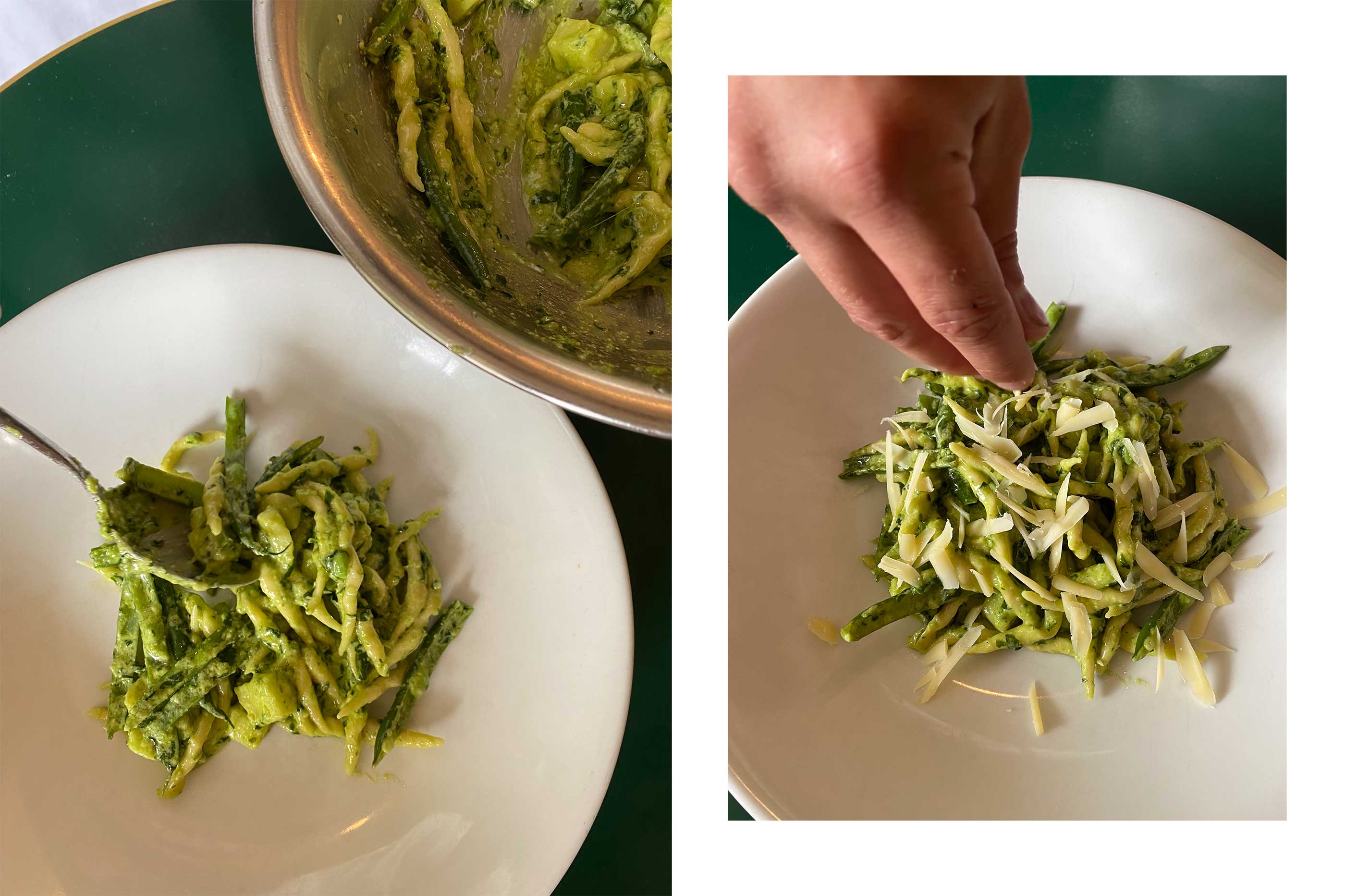
"As summer begins to roll upon us, it's time for aromatics and tender new season vegetables. This dish, this recipe, summer." 10 William St chef Francesco Ruggiero says about their new summer pasta dish. Below, is a recipe for pesto pasta with green beans and potatoes. As Ruggiero advises: "Eat, shaded by the late setting sun, with the slightest breeze. Wine, yes, natural of course, maybe a vermentino, licked by seaspray, kissed by citrus and wild herbs or a smoky, lacy rose from Sicily like summer rain on hot tar road."
Ingredients
Serves four
For the pesto
Basil leaves 105g
Extra virgin olive oil 105g
Parmigiano 60g
Pecorino 60g
Pine nuts 45g
Half a garlic clove
Corse salt 4g
Mortar and pestle
For the fresh Trofie pasta
Pasta flour 500g
Lukewarm water 200g
Pinch of salt (for cooking the pasta)
To garnish
Green beans, cut and boiled 100g
Kipfler potato, cut into cubes and boiled 100g
Comte 24-month aged 20g
Instructions
Trofie
Place the flour on a board or clean bench top and make a hole in the centre. Pour in the lukewarm water and combine the ingredients together with your hands. Knead the dough energetically for 10 minutes. If the dough is too soft, add more flour. If it’s too hard, wet your hands with water and keep kneading.
You will know when to stop kneading when your dough starts to feel smooth and silky instead of rough and floury. Form it into a large lump, cover with cling film or a cotton towel, and leave to rest for 30 minutes.
While it’s resting, you can make the pesto.
To shape the pasta into Trofie, pinch off a piece of dough about the size of a chickpea. Try to keep the rest of the dough covered to stop it from drying out. Place the piece of dough you pinched off onto a clean surface, and using the palm of your hand, roll the dough back and forth into a worm shape. After rolling forward, push down slightly on the piece of dough with your pinky and roll backward on a diagonal angle. This will give the Trofie the classic twisted shape, with the ends being thinner than the middle part.
Once you have shaped all the dough into Trofie pasta, leave to rest for 10 minutes.
Pesto
Remove the basil leaves from the stem. Rinse under cold water and place on a towel to dry. The leaves need to be dry before placing in the mortar.
Cut the garlic clove in half and remove the germ from one half. Place the half garlic clove in the mortar (you can discard the other half). Add the salt. Using the pestle, pound the garlic and salt into a rough paste.
Add the pine nut, pound them and then grind them into a creamy paste.
Add the basil leaves in handfuls and pound them. Once the leaves are crushed, grind them in a circular grinding movement with the pestle. Add another handful of basil leaves and repeat both steps. Once in a while, use a spoon to scrape down the leaves from the side and keep grinding and grinding until it all succumbs to you.
When you get a creamy consistency, start to add the parmigiano and pecorino.
Once all the ingredients are combined into a paste, add the olive oil little by little, grinding, rolling and grinding, as you go for a couple of minutes.
You will have an unctuously creamy, vibrant sun drenched green pesto
Leave to the side.
Cooking the pasta and garnishing
Bring a pot of water to the boil and add a good pinch of salt.
Peel the kipfler potatoes and cut into 1cm cubes. Chop the ends off the green beans and cut into 4cm long pieces. Add the potato and green beans to the boiling water and cook for 5 minutes. After 2 minutes, add the pasta and cook with the beans and potato for 3 minutes or until the pasta is al dente. The pasta should rise to the top when it’s ready.
Drain the pasta, potato and green beans, keeping some of the pasta water. Place the ingredients in a bowl and mix with the pesto. Add some of the pasta water to emulsify and mix until you obtain a creamy consistency.
Serve into bowls, then grate over 24-month aged Comte and good drizzle of extra virgin olive oil.
A few notes: if you don't have a mortar and pestle and want to use a blender or processor, add a couple of ice blocks. This will prevent the basil from overheating and losing that beautiful green.
Also, if you must, there are a couple of good quality dry packets versions about, also Linguine is a fine alternative.



